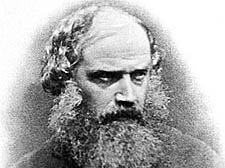|
|
 |
| |

Phiz |
A Dickens of a character
Dickens’ novels were always famous for their illustrations. But little is known about the illustrator, Phiz, until now. Jane Wild finds he led a life as extraordinary as any of the characters he drew
PHIZ. THE MAN WHO DREW DICKENS
Pimlico. £8.99. For more free public lectures at Gresham College visit www.gresham.ac.uk.
BORN the illegitimate son of a captain in Napoleon’s army, his life was as colourful as many of the characters created by his employer, Charles Dickens. Yet today not much is known of Phiz.
Phiz, whose real name was Hablot Knight Browne, was Dickens’s principal illustrator, working on 10 of his 15 novels over 23 years.
But it was more than just a working relationship; the pair became great friends, socialising and travelling together.
Now Phiz’s story has been told, in a new book researched and written by his great-great-granddaughter Valerie Browne Lester.
She has spent the last seven years researching his background and last week delivered a free lecture on his life at Gresham College, Holborn.
She said: “Phiz’s truly lucky break at the age of just 20, when he was suddenly chosen to pick up the reins on the Pickwick Papers, following the suicide of Robert Seymour and the firing of Robert Buss.
“Competition for the job was fierce. Dickens wanted someone young and agreeable who he could dominate.”
That competition included novelist William Makepeace Thackeray, who showed he was a gracious loser by taking Phiz out for a celebratory dinner of sausages and stout.
Ms Browne Lester said: “Phiz worked through the night to produce his first etching, The First Appearance of Mr Samuel Weller.
“With that, and the sudden popularity of Pickwick, Phiz’s career as an illustrator was assured. Sales zoomed up from 400 to an astonishing 40,000 copies for each monthly part.”
Like many of the characters he etched, Phiz’s own life was also far from mundane. He was brought up as one of the 15 children of William Loder Brown and Catherine Hunter Browne, but it was kept a secret that his true parents were Kate, the oldest daughter of the family and Nicolas Hablot, a horse grenadier in the old guard of Napoleon’s Imperial Guard. Kate was 21 and his father 34.
Valerie said: “Phiz was baptised in memory of his natural father. The family assumed the gallant Captain Hablot had lost his life in the Battle of Waterloo.
“But it turns out that he retired from the army and went to live in Carignan, eastern France, where he later married a local 18-year-old.”
When Phiz was seven, William Loder Browne embezzled trust funds and fled to Philadelphia, changing his name and beginning a new life as an artist. Phiz’s mother pronounced him dead, and the family moved to Euston. After attending boarding school in Suffolk, Phiz, as a struggling young artist, lodged at quite a few addresses in Camden, including Newman Street, Bedford Place, Warren Street, Fitzroy Street and Doughty Street, before relocating to Howland Street in 1840 after his marriage to Susannah Reynolds.
Valerie said: “The British Museum was his favourite haunt. He would often drop in and spend time with the Elgin Marbles, admiring the horses in particular.”
In May 1837 he and Dickens took a coach to Yorkshire, supposedly on a mission to find a boarding school for a poor widow’s son, but in actual fact to research the hardships at such schools for what was to become Nicholas Nickleby.
Asking around for the worst schools, they made their way to Bowes Academy, in the village of Bowes, where they met headmaster William Shaw.
Phiz forever preserved his likeness as the cruel schoolmaster Wackford Squeers. Phiz also worked with Dickens on The Old Curiosity Shop, Barnaby Rudge, Martin Chuzzlewit, Dombey and Son, David Copperfield, Bleak House and Little Dorrit.
And he went on to illustrate for Harrison Ainsworth, Anthony Trollope and Charles Lever. A Tale of Two Cities was the last novel he would illustrate for Dickens. Valerie said: “During the writing of Little Dorrit, Dickens began the plunge into a gigantic midlife crisis, which was full-blown by the time he was working on A Tale of Two Cities.
“He shed his wife, his publishers Bradbury and Evans and his loyal illustrator Phiz.”
She added: “The writer and critic GK Chesterton described the early heady days of their relationship so well.
“He said ‘They were as suited to each other and to the common creation of a unique thing as Gilbert and Sullivan. No other illustrator ever created the true Dickens atmosphere, in which clerks are clerks and yet at the same time elves.” |
 |
| |
|
 |
|


